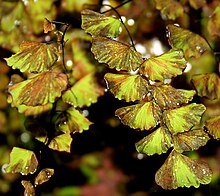Pteridales
| Pteridales | |
|---|---|
 |
|
| Adiantum lunulatum in Goa, India. | |
| Scientific classification | |
| Kingdom: | Plantae |
| Division: | Pteridophyta |
| Class: | Polypodiopsida / Pteridopsida (disputed) |
| Order: | Pteridales |
| Families | |
The Pteridales are ferns that have their sori in linear strips under the edge of the leaf tissue, usually with the edge of the lamina reflexed over.
This order is considered a family under the Smith classification. However, this group, a natural clade, is clearly the most basal offshoot of the entire polypodioid line, and if any portion of that clade is segregated as a separate order, this would be the obvious one. For this reason, and because this is a large and complex group, it is being considered an order for this page.
Most members of this order are small, but some members of the tropical genus Acrostichum, in the Ceratopteridaceae, are immense, with fronds 3.5 meters (twelve feet) tall.
One of the most well known plants in this order is the maidenhair fern Adiantum, with many forms in cultivation. Also commonly cultivated are various species of Pteris, sometimes known as "table ferns," and some species of Pellaea, including the button fern.
While this group has long been recognized as distinct from the rest of the polypodioid ferns, relationships within the group have long been misunderstood. A ground-breaking paper by Schuettpelz et al. has redefined this order using not only morphological data, but also extensive genetic data. The cladogram at left is based on their data. Line length in this diagram is not meaningful.
Cheilanthes, Pellaea, Doryopteris, Jamesonia, Anogramma, and Pteris have all been shown to be seriously paraphyletic genera. Jamesonia and Eriosorus were found to be a highly paraphyletic mixture, although in their own clade. More surprisingly, they found that the vittarioid ferns nest within the genus Adiantum. And they have established that Acrostichum and Ceratopteris are allied within their own isolated clade.
...
Wikipedia
